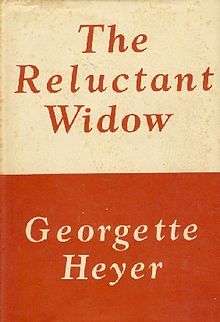The Reluctant Widow
 First edition cover | |
| Author | Georgette Heyer |
|---|---|
| Country | United Kingdom |
| Language | English |
| Genre | Regency, Romance |
| Publisher | Heinemann |
Publication date | 1946 |
| Media type | |
| Pages | 306 pp |
The Reluctant Widow is a Regency romance novel by Georgette Heyer which describes the story of the heroine Elinor Rochdale who has her life turned upside down when she enters the wrong carriage on her way to be a governess to sustain herself. The story is set in early 1813.[1] It was adapted into a movie in 1950.
Plot summary
The heroine, Elinor Rochdale, daughter of a ruined gentleman, accepts the role of a governess to sustain herself. Stepping into the wrong carriage at a Sussex village, Elinor finds herself in the wrong house, required by the sensible, sophisticated Edward Carlyon to marry his profligate cousin, Eustace Cheviot. In a somewhat dazed state, Elinor soon finds herself coerced into becoming the wife of a dying man, the mistress of a ruined estate and a partner in a secret conspiracy to save the family's name in only one night.
Following Eustace's death, a sub-plot surrounding Cheviot and information supplied to the French - with whom the country is at war - comes to light and results in some spirited battles between Elinor and Carlyon. Ultimately, the incriminating information is taken back into safe hands and Elinor and Carlyon fall in love.
Characters
Miss Elinor Rochdale - the heroine, 26
Edward 'Ned', Lord Carlyon
Eustace Cheviot - master of High Noons, cousin of Lord Carlyon
John Carlyon - a diplomat, younger brother of Lord Carlyon
Mr and Mrs Barrow - retainers at High Noons
Nicky Carlyon - youngest brother of Edward, rusticated from Oxford
Bouncer - Nicky's dog
Lord Beddlington - uncle of Eustace Cheviot
Francis Cheviot - son of Lord Beddlington
Louis de Castres - son of a French emigre
Film adaptations
It was adapted into a comedy released in April 1950 directed by Bernard Knowles.